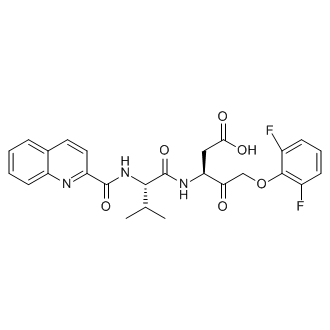| Size | Price | Stock |
|---|---|---|
| 1mg | $60 | In-stock |
| 5mg | $108 | In-stock |
| 10mg | $180 | In-stock |
| 25mg | $288 | In-stock |
| 50mg | $528 | In-stock |
| 100mg | $850 | In-stock |
| 200 mg | Get quote | |
| 500 mg | Get quote | |
| We match the lowest price on market. | ||
We offer a substantial discount on larger orders, please inquire via [email protected]
or Fax: (86)21-58955996
Inquiry for price and availability only. Please place your order via our email or fax.
| Cat. No. : | HY-12305 |
| M.Wt: | 513.49 |
| Formula: | C26H25F2N3O6 |
| Purity: | >98 % |
| Solubility: | DMSO : 100 mg/mL (194.75 mM; Need ultrasonic) |
Q-VD-OPh is an irreversible pan-caspase inhibitor with potent antiapoptotic properties; inhibits caspase 7 with an IC50 of 48 nM and 25-400 nM for other caspases including caspase 1, 3, 8, 9, 10, and 12. Q-VD-OPh can inhibits HIV infection. Q-VD-OPh is able to cross the blood-brain barrier. IC50 & Target: IC50: 48 nM (caspase 7), 25-400 nM (caspase 1, 3, 8, 9, 10, and 12)[1] In Vitro: Q-VD-OPh is a potent inhibitor of caspase-7 with an IC50 of 48 nM utilizing a cell-free assay consisting of human recombinant caspase-7, Q-VD-OPh, and the substrate AMC-DEVD-pNa[1]. Q-VD-OPh fully inhibits caspase-3 and -7 activity at 0.05 μM. Caspase-8 is also inhibited at low Q-VD-OPh concentrations. The cleavage of PARP-1 is fully prevented at 10 μM Q-VD-OPh. DNA fragmentation and disruption of the cell membrane functionality are both prevented at 2 μM Q-VD-OPh[2]. Q-VD-OPh is significantly more effective in preventing apoptosis than the widely used inhibitors, ZVAD-fmk and Boc-D-fmk, and is also equally effective in preventing apoptosis mediated by the three major apoptotic pathways, caspase 9/3, caspase 8/10, and caspase12. Q-VD-OPh is not toxic to cells even at extremely high concentrations[3]. QVD is also able to increase the expression of differentiation markers in acute myeloid leukemia (AmL) blasts. QVD alone or combined with VDDs increases differentiation and HPK1-cJun signaling in AmL cell context-dependent manner[4]. In Vivo: Chronic treatment with Q-VD-OPh prevents caspase-7 activation and limits the pathological changes associated with tau, including caspase cleavage. Q-VD-OPh could be a potential therapeutic compound for the treatment of Alzheimer's disease[1].
Lorem ipsum dolor sit amet, consectetur adipisicing elit. Autem earum hic iste maiores, nam neque rem suscipit. Adipisci consequatur error exercitationem fugit ipsam optio qui, quibusdam repellendus sed vero! Debitis.
Inquiry Information- Product Name:
- Q-VD-OPh
- Cat. No.:
- HY-12305
- Quantity:


Your information is safe with us.